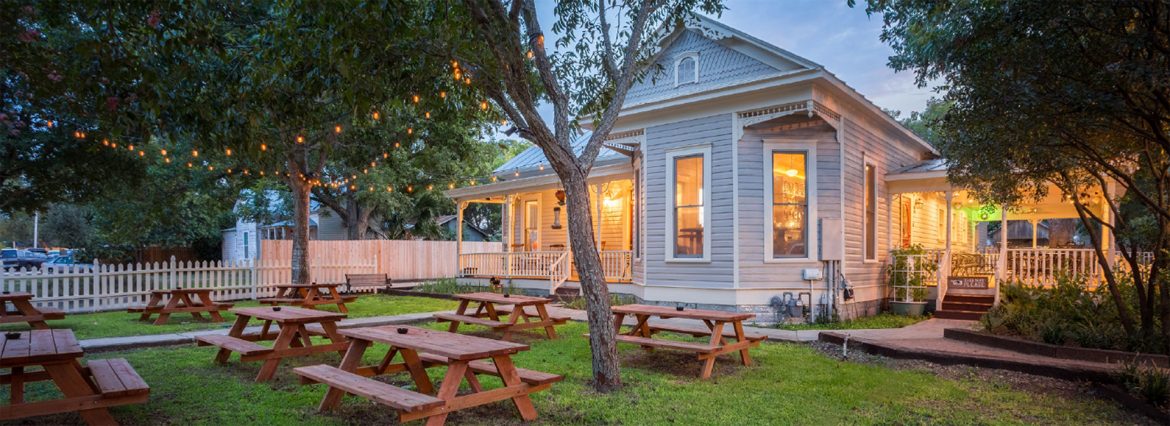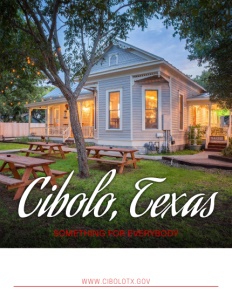Cibolo, Texas
Something for everybody
Business View Magazine interviews Kelsee Jordan Lee, Cibolo’s Interim Director of Economic Development – best practices of American towns and cities.
The City of Cibolo is located in Guadalupe County in south-central Texas, approximately 13 miles northeast of San Antonio, and 15 miles southwest of New Braunfels, with frontage on both Interstate Highway 35, and IH-10. The modern story of the city began in 1876, when the Southern Pacific Railroad cut through present day Cibolo, connecting it with other larger cities such as Houston and San Antonio. The fertile land and the flowing Cibolo Creek in the Cibolo Valley provided ideal conditions for a boom in agriculture, and for several decades, cotton was the area’s major cash crop, followed by corn, wheat, oats, and milo maize, or sorghum.
Today, the small city of approximately 31,000 is moving away from its traditional character as a mere bedroom community of the San Antonio/New Braunfels Metropolitan Statistical Area, and is carving out its own unique identity as a thriving residential, commercial, and industrial powerhouse of Guadalupe County.
A key player in that transformation is the Cibolo Economic Development Corporation (CEDC), a non-profit entity created in 2007 by the citizens of Cibolo and tasked to create jobs by attracting targeted industries and commercial development to the city, while simultaneously working to retain and assist in the expansion of its existing businesses. The CEDC uses money raised by a sales tax for a wide variety of projects, including land, buildings, equipment, and facilities expenditures and improvements.
“The city has been proactively aggressive in working with business,” explains Kelsee Jordan Lee, Interim Director of Economic Development for the City. “And we’ve seen a shift from just focusing on incentives that might support one or two businesses (although we do have a strong incentive program that we can pull out when it’s needed) to laying the groundwork that supports all of our businesses through infrastructure improvements, workforce development partnerships, and investing in more quality of life projects.”
Regarding the first item on that list, Lee reports, “The city has been tackling infrastructure and moving away from a reactive position to a more proactive strategy. We’ve recently issued $7.5 million in certificates of obligation for road improvements to major thoroughfares around the city. We also have a street maintenance fund, which receives part of the collected sales tax, which the city then reinvests into roads around the city. The city has also expanded its sanitary sewer, and is constructing a new lift station along one of our major commercial corridors to help expand capacity and be prepared for additional commercial, residential, and industrial growth. This is in addition to expanded water lines in that area. We’ve also seen our local utility providers make some really great strides in bringing electrical, telecommunications, natural gas, sewer, and water to the area south along IH-10. These improvements have helped turn what used to be rural areas into sites that are prime real estate for commercial and industrial users.”

Kelsee Jordan Lee, Deputy Director of the CEDC
“Also, we have a strong retail demand,” Lee adds. “It’s about $340 million of unmet demand that’s been waiting for businesses to come in and set up shop. So, we’re seeing a lot of commercial businesses come in because of that demand. We also have a little higher median household income for the area, so we have citizens who are ready and able to support new retail and restaurant operators.”
Regarding the workforce situation, Lee notes that the available labor force in the San Antonio/New Bruanfels MSA of approximately 1.2 million people includes a large number of military veterans who bring pride and discipline to their work. “We’re near several bases and when a lot of those service members decide to retire or leave the military, they come to our area. In fact, about 24 percent of our population is former military,” she states. “In addition, our school district has been very active in preparing our students to be college, career, or military-ready. They offer a number of career and technical education programs – agriculture, mechanics, architecture/design, cyber security, robotics, engineering, etc. So, we’ve seen a lot of workforce development initiatives to make sure we can support businesses that are coming to the area.”
A major coup for the city and the CDEC was the recent, successful recruitment to Cibolo of a company called AW Texas, a subsidiary of Aisin, a Japanese manufacturer of automotive transmissions. “They chose the Cibolo area so they can service their Toyota manufacturing plant in San Antonio,” says Lee. A new $400-million, 500,000-sq.-ft. facility is currently under construction, and the new plant is expected to begin production in September 2021, bringing 900 jobs to the region by the end of 2023.
“It was a very competitive process,” Lee recounts. “We found out, afterward, that there were over 90 locations throughout the entire United States that were being considered. We worked with our regional partners, such as the San Antonio Economic Development Foundation and the Guadalupe Valley Development Corporation. One of the reasons why Cibolo was attractive was purely geography – they wanted to be close enough to the Toyota plant to be able to send their finished materials there, but they wanted to be far enough away so that they weren’t competing for the same resources and labor pool.”
“Early on, we brought in Workforce Solutions Alamo, which is the workforce development board for our area,” Lee continues. “They came to the initial meetings and talked to the AW Texas team about what sort of workforce training there could be, and any grants that the state could add for workforce training. And that was a big thing for them.” Regarding financial incentives, both the city and county leaders approved an economic development incentive package for AW Texas that included tax abatements, as well as a Chapter 380 Economic Development Agreement. The 20-year agreement with the City of Cibolo is valued at $9.6 million while the county’s agreement is worth $13 million. The project is expected to bring a $36-million payroll to Cibolo and deliver an annual net benefit of $3.7 million to the city and $4.5 million to the county in sales and property taxes.
“We also did some improvements to the area,” Lee adds. “We did a $5-million bond project to help improve some drainage and also road work around the site. We also partnered with the Texas Department of Transportation to get $150 million in improvement to IH-10. That was also a big deal in order to secure Aisin coming. They wanted to make sure their trucks, their deliveries, and their workers would be able to get to and from the site, safely. A lot of times people think of small towns as not having much in the way of industry, but being able to recruit a major player like this really helps show that we’re here to play ball and we have the ability to work with our partners to bring big players like this to Cibolo.”
Another upcoming development, this one off of IH-35 is called Cibolo Crossing. It’s a 116-acre, mixed-use development, currently under construction, that Lee says will be the city’s “crown jewel.” The project is anchored by a Santikos movie theater, with laser tag, a bowling alley, a sports bar, restaurants, and other retail outlets attached. “It also has about 750 apartments being built,” says Lee, “and will also incorporate office space, with plans to put in a hotel and a childcare center. So, people can live, work, and play, in one place.”
Finally, regarding quality of life amenities, Lee says that the Old Town district of downtown Cibolo has seen a lot of growth lately, helping to make it more of a local and regional destination. “A few years back, the city and the Economic Development Corporation commissioned a downtown revitalization study, which looked at our urban core and made recommendations,” she shares. “And we have since implemented some changes, such as an overlay district for the area which allows for some flexibility, like allowing one property to be zoned for residential and commercial uses. The Cibolo Economic Development Corporation also paid to improve sidewalks for pedestrian mobility and to improve parking lots downtown. The CEDC also offers a business improvement grant to help promote tourism in that area and so new businesses, or existing businesses that are located there and contribute to tourism in Cibolo, are eligible to apply. It’s up to $10,000 in reimbursement for exterior improvements. That’s another way we’re trying to encourage tourism and that sense of place in Cibolo. And, we’re really excited because a couple of brave entrepreneurs have started their own retail and restaurant operations in the cultural heart of our city. We now have a yoga studio, an acupuncturist, an art studio, a wine bar, a cigar lounge, a children’s education center, and multiple professional offices and restaurants there. So, it’s definitely starting to make a name for itself in the region. The city also commissioned a mural wall. We see a lot of people taking selfies in front of it.”
 Christine Pollok, Cibolo’s Public Relations Manager, adds, “We just built a new YMCA in partnership with the YMCA of Greater San Antonio. Part of that YMCA is a sports complex with baseball fields. The city has bioswales in lieu of detention ponds and we led by example by constructing a bioswale as part of our sports complex parking lot to show that sustainability can also be visually appealing. We also just passed a bond for a Miracle League field for adults and children with developmental differences.”
Christine Pollok, Cibolo’s Public Relations Manager, adds, “We just built a new YMCA in partnership with the YMCA of Greater San Antonio. Part of that YMCA is a sports complex with baseball fields. The city has bioswales in lieu of detention ponds and we led by example by constructing a bioswale as part of our sports complex parking lot to show that sustainability can also be visually appealing. We also just passed a bond for a Miracle League field for adults and children with developmental differences.”
“Cibolo is growing at an exponential rate and not just in one aspect,” Pollok adds, in conclusion. “We’re growing in our industrial outreach, our commercial growth, and our residential growth. We have different housing styles from garden homes to apartments to traditional single-family. In Cibolo, we have something for everybody.”
AT A GLANCE
Cibolo, Texas
WHAT: A city of 31,000
WHERE: In south-central Texas, northeast of San Antonio
WEBSITE: www.cibolotx.gov
PREFERRED VENDORS
Highridge Costa – www.housingpartners.com
For more than 26 years, Highridge Costa has excelled as an innovator in the complex field of affordable housing, successfully meeting the challenge to develop quality new housing for underserved families and seniors faced with the need for housing that is affordable.
The company has been a leader in affordable housing having developed over 30,000 units, and more than 290 communities in 33 states and Puerto Rico all of which have been designed to integrate seamlessly into existing neighborhoods whether rural, suburban or city settings. All have been financed using the most successful affordable housing finance program, utilizing Federal Low-Income Housing Tax Credits (LIHTC).
In 2019, Highridge Costa held a ribbon-cutting ceremony for El Sereno Senior Living, a newly developed $21 million apartment community in Cibolo, Texas. A true public/private partnership – one of the first of its kind in south-central Texas – providing much needed affordable housing for seniors. The Cibolo City Council endorsed and supported El Sereno from the beginning planning stages to its grand opening.
“Few industries have a greater impact on low-income Americans than does ours”, says Highridge Costa President and CEO Michael Costa. “We take tremendous pride in creating quality new affordable multifamily and senior housing for people who are of lesser means or even homeless. We feel very fortunate that our “work” changes lives for so many seniors and families throughout the nation.”
Valcor – https://valcorcre.com/portfolio-posts/cibolo-crossing
Midland-based Cromwell Street LLC and Grey Forest Development LLC, subsidiaries of Fasken Oil and Ranch, have chosen Cibolo as the location for its 116-acre, $285 million mixed use development. “We are creating an atmosphere where people can live, work and play.”
The development will include 305 state of the art apartment homes, Santikos Entertainment Center, retail space and restaurants.
As a long-term owner, Fasken makes sure the investment maintains its value for the long term. “Our focus is on a high level of quality.”
We study each site to ensure the product complements the tract of land and the surrounding neighborhoods. “We’re not just taking some prototype and putting it down. We are designing a product that is compatible with the community.”
About Fasken: Fasken is a family owned business with a 107-year history in energy exploration and production. Fasken is one of the largest independent oil-and-gas producers in Texas, as well as being one of the largest landowners in the US. Since the company diversified into real estate in 2003, Fasken has developed over 1.5 million SF of industrial buildings, 250,000 SF of office space, 46,000 SF of retail space, and over 2,000 apartment units completed or under development.






